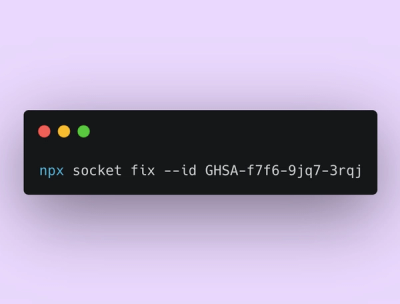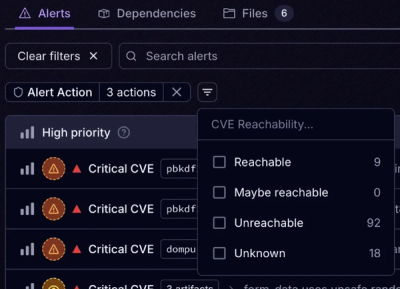
Product
Announcing Socket Fix 2.0
Socket Fix 2.0 brings targeted CVE remediation, smarter upgrade planning, and broader ecosystem support to help developers get to zero alerts.
chip-utils
Advanced tools
Utility methods used in some of the libraries created with Chip.
To use these utilites in your own project install using npm.
npm install chip-utils
This utility provides syntactic sugar on normal JavaScript class inheritance supporting additional features such as getters/setters and static inheriance.
To set up class inheritance, extend from the generic Class object. Then your classes will have an extend method and
can use it to extend to subclasses.
var Class = require('chip-utils/class');
function MyClass() {
}
Class.extend(MyClass);
function SubClass() {
}
MyClass.extend(SubClass);
Static properties will also be extended. You may use the static member property as a shortcut to defining statics, but
this is not necessary.
// Parent class
function Resource(data) {
if (data) {
Object.keys(data).forEach(function(key) {
this[key] = data[key];
}, this);
}
}
Resource.uri = '/api/v1'
Resource.load = function() {
var ResourceType = this;
return $.getJSON(this.uri).then(function(items) {
return items.map(function(item) {
return new ResourceType(item);
})
});
};
Class.extend(Resource, {
save: function() {
var uri = this.constructor.uri + '/' + this.id;
// Save code here
};
});
function Person(data) {
Resource.call(this, data);
}
Resource.extend(Person);
// Define this AFTER calling extend writes it
Person.uri += '/people'
Person.load() // returns a promise full of Person objects
Using the static member property:
Resource.extend(Person, {
static: {
uri: '/api/v1/people'
}
});
Mixins or multiple inhertiance allows for adding methods from multiple classes.
// Person will inherit from Resource, but will also get the methods from EventTarget
function Person(data) {
// Calling both constructors to ensure we are initialized correctly
Resource.call(this, data);
EventTarget.call(this);
}
Resource.extend(Person, EventTarget, {
save: function() {
this.dispatchEvent(new Event('save'));
return Resource.prototype.save.call(this);
}
});
var p = new Person();
p.on('save', function() {
console.log('Person was saved!');
});
The extended mixins and the prototype of the class can safely use getters/setters.
function Person(firstName, lastName) {
this.firstName = firstName;
this.lastName = lastName;
}
Class.extend(Person, {
get name() {
return this.firstName + ' ' + this.lastName;
},
set name(value) {
var parts = value.split(' ');
this.firstName = parts[0];
this.lastName = parts[1];
}
});
function Friend(firstName, lastName, nickName) {
Person.call(this, firstName, lastName);
this.nickName = nickName;
}
Person.extend(Friend, {
get name() {
return this.nickName;
},
set name(value) {
this.nickName = value;
}
});
var rando = new Person('John', 'Smith');
var friend = new Friend('Robert', 'Haroldson', 'Bob');
console.log(rando.name); // John Smith
console.log(friend.name); // Bob
friend.name = 'Rob';
console.log(friend.nickName); // Rob
This utility ties into the browser eventing system and exposes it for your libraries to use. This does not work in
node.js. EventTarget extends from Class so anything extending it will take advantage of the extension system. Or it
may be used as a mixin as described above, just be sure to call the constructor within your subclass' constructor.
To extend the event target:
var EventTarget = require('chip-utils/event-target');
function MyClass() {
EventTarget.call(this);
}
EventTarget.extend(MyClass, {
save: function() {
// Use the cancelable flag to allow actions to be canceled by listeners
var event = new Event('saving', { cancelable: true });
this.dispatchEvent(event);
if (!event.defaultPrevented) {
var self = this;
$.ajax(
type: 'PUT',
url: '/items/' + this.id,
contentType: 'application/json',
data: JSON.stringify(this)
).then(function() {
// Signal the save is complete
self.dispatchEvent(new Event('save'));
}, function(err) {
// Use custom events to add additional data
self.dispatchEvent(new CustomEvent('error', { detail: err}));
});
}
}
});
To listen to events on an event target (or remove listeners:
var obj = new MyClass();
obj.on('saving', function(event) {
if (event.target.ownerId !== me.id) {
event.preventDefault();
}
});
// Will only get called once
obj.one('save', function() {
alert('First save');
});
// `on` and `off` are aliases of `addEventListener` and `removeEventListener`
obj.addEventListener('save', myListener);
obj.removeEventListener('save', myListener);
obj.on('save', myListener);
obj.off('save', myListener);
This EventTarget class will only work in the browser (or jsdom) since it uses a native EventTarget to work with the browser's eventing system. It does not support bubbling.
FAQs
A few basic utilities for use within chip-supported libraries
The npm package chip-utils receives a total of 13 weekly downloads. As such, chip-utils popularity was classified as not popular.
We found that chip-utils demonstrated a not healthy version release cadence and project activity because the last version was released a year ago. It has 3 open source maintainers collaborating on the project.
Did you know?

Socket for GitHub automatically highlights issues in each pull request and monitors the health of all your open source dependencies. Discover the contents of your packages and block harmful activity before you install or update your dependencies.

Product
Socket Fix 2.0 brings targeted CVE remediation, smarter upgrade planning, and broader ecosystem support to help developers get to zero alerts.

Security News
Socket CEO Feross Aboukhadijeh joins Risky Business Weekly to unpack recent npm phishing attacks, their limited impact, and the risks if attackers get smarter.

Product
Socket’s new Tier 1 Reachability filters out up to 80% of irrelevant CVEs, so security teams can focus on the vulnerabilities that matter.